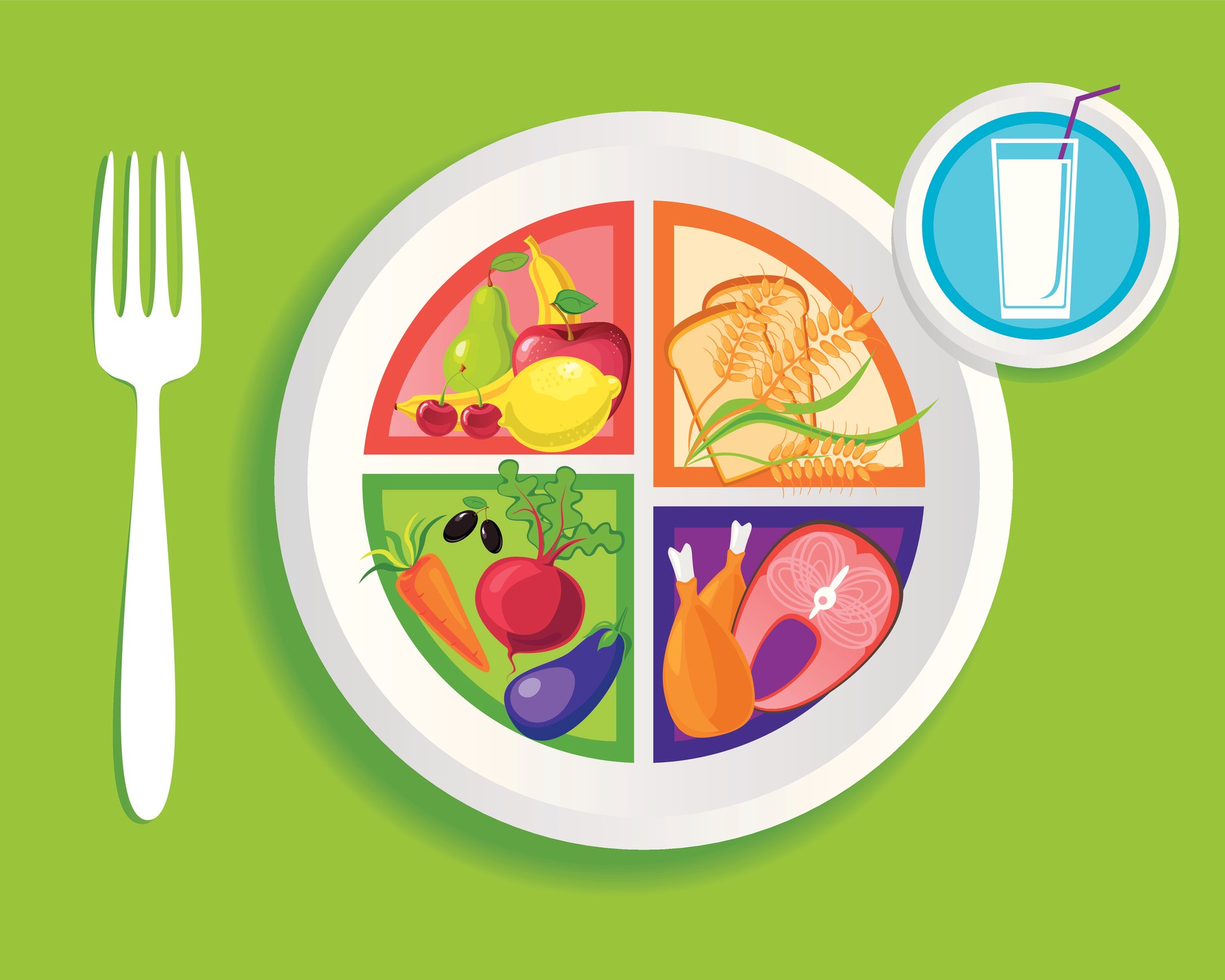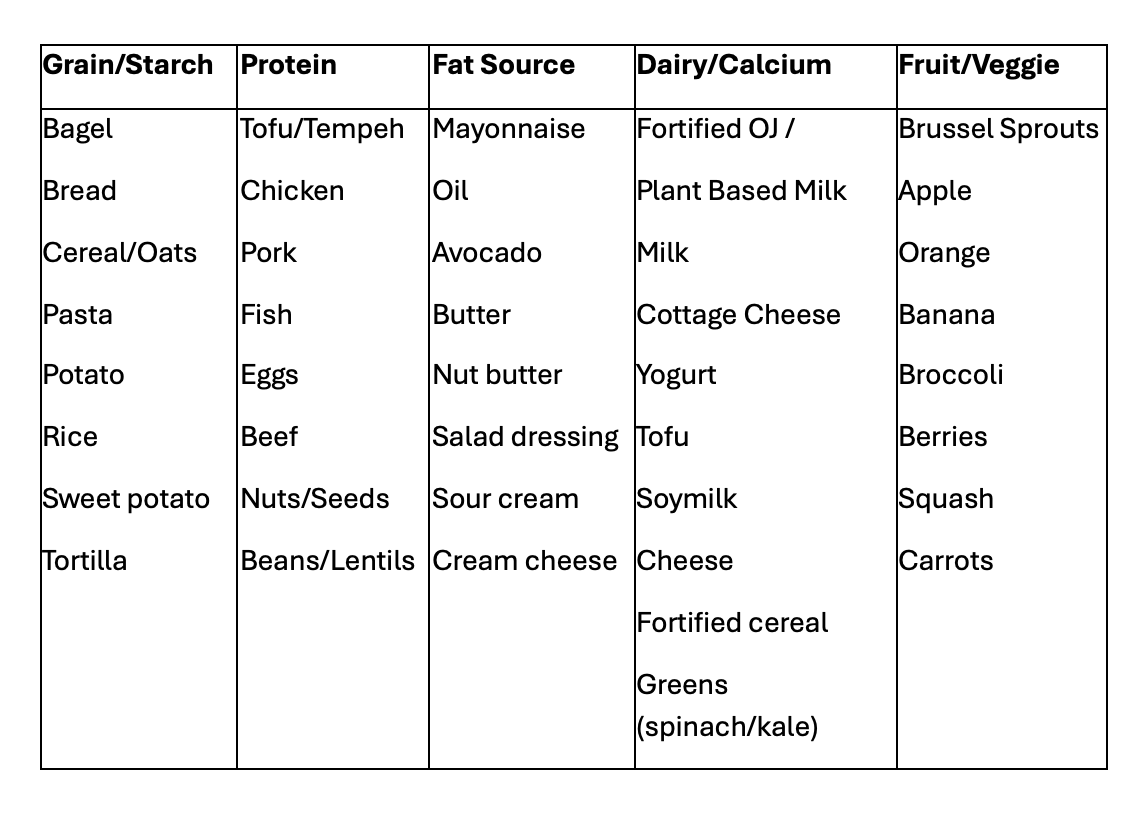1. Encourage a Regular Meal and Snack Pattern
Children thrive when they have a consistent meal schedule. Having regularly scheduled meals and snacks helps children learn to trust their bodies and maintain their ability to listen to their hunger and fullness signals.
In general, having 4-6 eating opportunities per day will help ensure your child meets their nutrition needs. This could look like 3 full meals and 1-3 snacks, or it could be 5-6 “mini” meals. While balanced snacks are a key part of a healthy diet, we recommend limiting grazing throughout the day. This will allow your child to still feel hungry at mealtimes and likely be more interested in exploring new foods.
Along with a consistent meal schedule, children benefit from a strategy called “The Division of Responsibility in Feeding.” This method was developed by Ellyn Satter, a Registered Dietitian and Family Therapist. Her organization, The Ellyn Satter Institute, provides research, tips and resources to support families throughout the process of raising a competent eater.
The Division of Responsibility puts parents and caregivers in charge of when meals are served (meal and snack schedule), where the child sits for meals, and what foods are offered at each meal and snack. The child is in charge of whether to eat at each meal, and how much food they eat.
Family meals are one foundation of cultivating long-term health. Ellyn Satter shares, “Children and teens who have family meals eat better, feel better about themselves, get along better with other people, and do better in school. They are less likely to gain more weight than is right for them, abuse drugs, smoke, and have sex. In fact, family meals have more to do with raising healthy, happy children than family income, whether the child has one or two parents living in the home, after-school activities, tutors, or church.”
When planning family meals, be considerate of your child’s food tolerances, but do not cater to their preferences at every meal. Be sure to serve 1-2 items (even if they are side dishes) at each meal that you feel they will tolerate as they gain food experience. Prepare the foods that you enjoy eating and your children will learn to eat what you eat.
If you are feeling stuck or unsure how to start implementing more family meals at home, reach out to our nutrition team at COPA – we would love to meet you where you are and support your nutrition goals at home.
2. Offer a Balanced Diet to Support Long-Term Health
Another foundation of health is exposure to a variety of foods served as part of a balanced meal. The “MyPlate” method was launched in 2011 and replaced the “Food Pyramid” to guide balanced, healthful eating using food groups. The MyPlate method emphasizes small changes that add up over time. This method recommends making half your plate fruits and veggies, choosing more whole grains, including a variety of protein foods, and selecting low-fat or fat-free dairy products or fortified alternatives.
The following graphic can be a great resource for families when planning balanced meals. More information can be found at: https://www.myplate.gov/

Parents can guide their child’s nutrition habits by offering components from each food group at mealtimes. Children remain in charge of whether to eat each food and how much they want to eat. To get started with incorporating the MyPlate method, it can be helpful to make a list of foods from each food group that your family typically has in the household or enjoys. Here is an example below.
List of Food Groups and Examples

Additionally, offering balanced snacks in between established mealtimes is a great way to help children meet their nutrition needs and satisfy hunger during the day. To build a balanced snack, select an item from at least 2-3 food groups to offer. Here are some examples of easy, balanced snacks to try.
List of Balanced Snack Ideas
Snacks:
- Apple and peanut butter
- Nuts and dried fruit
- Cheese and crackers
- Pretzels and hummus
- Pita chips with hummus
- Carrots with ranch
- Bell peppers with ranch
- Energy bar and grapes
- Banana and cashews
- Yogurt and granola
- Yogurt and fruit
- Chocolate-covered almonds and melon
- Guacamole and tortilla chips
- Graham crackers and peanut butter
- Chocolate chip cookies and whole milk
- Strawberries and ice cream bar
- Banana bread and whole milk
If you are interested in more ideas about meal planning, offering new foods, varying textures of foods, or if you have concerns that your child is not eating enough volume or variety, please come see us for a nutrition visit! We also love to connect with and support families following a specific eating pattern; including gluten-free, dairy-free, vegan, or vegetarian.

3. Support Adequate Hydration, with Water as the Primary Source
Historically, fruit juice was recommended by pediatricians to keep kids hydrated and provide Vitamin C. More recent recommendations from the USDA include limiting juice to no more than 4-6 oz per day, and avoiding juice all together for children less than a year old. Serving whole fruits and vegetables instead of juice is the best way to provide adequate vitamins and minerals to keep your child healthy and growing appropriately.
It is also recommended to avoid giving sugar-sweetened beverages including sport drinks, soda, and water flavored with sugar to children less than 2 years old. These beverages can make children feel fuller and reduce their intake of nutritious foods throughout the day. Children also do not have room in their diets for the additional calories from the added sugars in these beverages.
For healthy children ages 1 year and older, serving cow’s milk can help meet needs for calcium, potassium, Vitamin D and protein. In general, try to limit your child’s intake of cow’s milk to no more than 16-20 oz per day. This is because excessive milk intake can impact absorption of essential nutrients, as well as fill your child up in the same way that juice or sugar-sweetened beverages can.
Water should be the primary source of fluids for your child over 1 year of age. Drinking enough water can help with digestion, bowel patterns, maintaining a normal body temperature, and protection of cells and tissues. Your active child also requires water throughout the day to replenish fluids as they play and run around.
If you have questions regarding your child’s individualized fluid goals, please schedule a nutrition appointment at COPA to review with your dietitian!
Resources:
- Ellyn Satter Institute, Eat and feed with joy
- My Plate, MyPlate | U.S. Department of Agriculture
- Dietary Guidelines for Americans, Home | Dietary Guidelines for Americans
